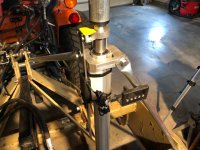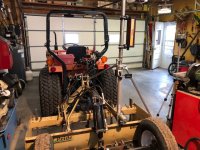How big of a job would it be for an electronics guru to design and spec all the components required for this system?
Here's how I would approach it. There's basically three parts: reading in the setting, controlling the blade movement, and the logic to connect the reading to the controlling. I would use a small microprocessor like an Arduino or a Raspberry Pi.
Reading: if the signal between the receiver and the remote is a standard protocol, both Arduino and Raspberry Pi have built-in processors for USB, RS232, I2C and other protocols. Reading the data is just a matter of connecting the right pins on the receiver plug to the right pins on the microprocessor board.
Controlling: Two ways of controlling the blade have been proposed, either using an electric hydraulic valve or using a power-steering type valve with a DC motor. The electric valve is not difficult, it just needs to be attached to one output pin of the microprocessor for up and another output for down. If the current or voltage requirements of the valve are different from what the pins can provide there needs to be an appropriate relay. Controlling the power-steering type valve is done by controlling the speed of a DC motor. This is commonly done by a technique called pulse width modulation, where pulses of electricity are sent to the motor, the longer the pulse the higher the speed. This requires attaching a single output pin of the microprocessor to the motor. Again, if the voltage or current requirement of the motor can't be met by the microprocessor pin a relay is necessary. If you were to take a course in using Arduinos or Raspberry Pi this is all stuff you would learn in the first month.
The third part is the control logic, this is a program that runs on the microprocessor. This is the big wildcard. It could be as simple as "once a second, read the blade height. If it's too low raise it, if it's too high lower it. Repeat." Or it could be that you need to keep track of the history of the blade height and the history of commands you've given and adjust your response based on what's working. Or maybe you need the user to input some information about the hardness of the soil. Or maybe you need another sensor to tell you the speed of the tractor.
The control logic will take some trial and error, a lot of time just driving across fields and watching what happens. The reason I'd prefer Raspberry Pi for this, even though I have more experience with Arduino, is the RP has more capability for things like logging data and giving a display while it's working. If you were to do this with Arduino you'd probably have to have a laptop on the tractor with you while debugging log what's happening. I've also done projects like this where I had an Arduino-like device attached to the USB port of a smartphone and the phone provided the display and logging.


